
The Victor-Victrola Page

Victrola Design Details
1. Cabinets
2. Cranks, Brakes and Speed Controls
3. Soundboxes and Keys
4. Lid Supports, Record Albums and Needle Trays
Pictures and details on some of the design features of Internal Horn Victrola phonographs. Each sequential page covers one aspect of the evolving designs. Advance to the next page via the link above or at the bottom of each page
Design Details: Soundboxes and Keys
Victrolas came with a soundbox (which holds the needle and couples the record's vibrations to the horn system) and those models with lids also had a key. Some collectors refer to soundboxes as "reproducers", although this term was never used by Victor.
Soundboxes (provided in nickel, gold and antique bronze finishes)
Starting
with the introduction of the Victrola in 1906, many models used the
Exhibition Soundbox. This soundbox originated with external-horn
Victors in late 1904, and continued in production for well over 20 years. It
was a well-proven design, and was economical to manufacture. By the late
'teens, it was used only on inexpensive machines, external-horn models, and
those intended for export.
No 15
Soundbox.
Introduced with the
low-cost external-horn "Victor O" model in 1908, this
soundbox was used for a brief period on "Victrola IV" machines when
they were launched in 1911. It is essentially an Exhibition Soundbox with a
metal "shrouded" body which covers part of the mica diaphragm. This may have
been done to protect the diaphragm from damage when used by children. The "Victrola
IV" transitioned to the Exhibition Soundbox in 1912.
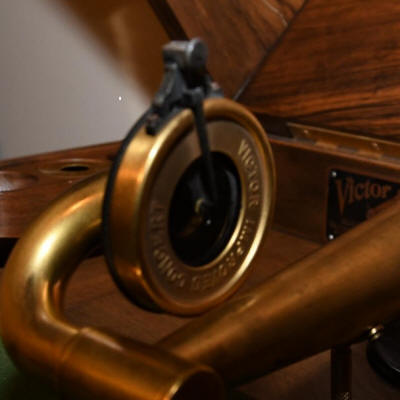 In
late 1912, Victor offered the Improved
Concert Soundbox as
an "upgrade" option to the Exhibition model. It provided slightly more
volume and improved sound, although based on the limited number of surviving
examples, very few were sold. It originally cost $3.00 in nickel and $7.00
in gold plate.
In
late 1912, Victor offered the Improved
Concert Soundbox as
an "upgrade" option to the Exhibition model. It provided slightly more
volume and improved sound, although based on the limited number of surviving
examples, very few were sold. It originally cost $3.00 in nickel and $7.00
in gold plate.
The
No. 2 Soundbox was introduced in time for the Christmas 1917
buying season. It was initially included on the premium Victrola models such as
the "VV-XVI" and "VV-XVII", but soon became standard equipment on
virtually all Victrola models, excepting for the lowest-price tabletop versions.
It became obsolete in 1925 with the introduction of the Orthophonic machines.
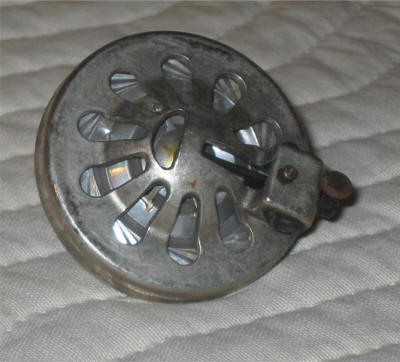 The
Orthophonic Soundbox was launched with the introduction of
Victor's Orthophonic product lineup in the fall of 1925. It became standard on
all floor model machines, and was offered on some of the better portables and
tabletop Victrolas. It replaced the long-running mica diaphragm, used on
virtually all soundboxes since 1901, with a stiffened, paper-thin aluminum
diaphragm. The stylus alignment was maintained via a pair of magnets, supported
on tiny ball bearings. The resulting sound quality was revolutionary,
with vastly improved frequency response and reduced compliance, making this
soundbox a perfect match for the new electrical recordings. This soundbox
remained in use on portable machines through much of the 1930's, even after
electrical reproduction had long since overtaken acoustic playback on most home
models.
The
Orthophonic Soundbox was launched with the introduction of
Victor's Orthophonic product lineup in the fall of 1925. It became standard on
all floor model machines, and was offered on some of the better portables and
tabletop Victrolas. It replaced the long-running mica diaphragm, used on
virtually all soundboxes since 1901, with a stiffened, paper-thin aluminum
diaphragm. The stylus alignment was maintained via a pair of magnets, supported
on tiny ball bearings. The resulting sound quality was revolutionary,
with vastly improved frequency response and reduced compliance, making this
soundbox a perfect match for the new electrical recordings. This soundbox
remained in use on portable machines through much of the 1930's, even after
electrical reproduction had long since overtaken acoustic playback on most home
models.
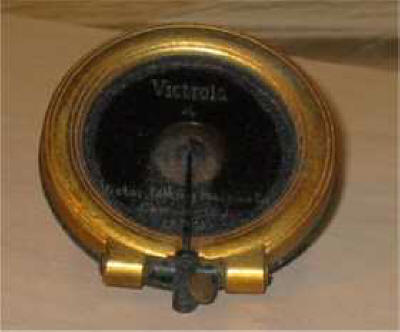 The
No. 4 Soundbox was introduced to replace the outdated Exhibition Soundbox in
1926 for the low-end tabletop and portable models when did not have
Orthophonic horns. It was essentially
a larger version of the No. 2 Soundbox, providing slightly improved
performance with the new electrical recordings. It was discontinued within
a few years.
The
No. 4 Soundbox was introduced to replace the outdated Exhibition Soundbox in
1926 for the low-end tabletop and portable models when did not have
Orthophonic horns. It was essentially
a larger version of the No. 2 Soundbox, providing slightly improved
performance with the new electrical recordings. It was discontinued within
a few years.
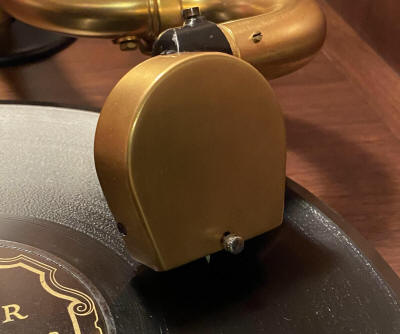 The
Victor "horseshoe magnet" Electrola Pickup was used
on all electronic (Electrola) phonographs, beginning in 1925. It went through
several design iterations over the course of almost 10 years (including the
later addition of the Victor "Nipper" logo being stamped on-front),
even after RCA bought-out the Victor Talking Machine Company. It was an
excellent performer; one of the first electromagnetic phono pick-ups to be
mass-produced.
The
Victor "horseshoe magnet" Electrola Pickup was used
on all electronic (Electrola) phonographs, beginning in 1925. It went through
several design iterations over the course of almost 10 years (including the
later addition of the Victor "Nipper" logo being stamped on-front),
even after RCA bought-out the Victor Talking Machine Company. It was an
excellent performer; one of the first electromagnetic phono pick-ups to be
mass-produced.
When
"Radio-Adaptable" Victrolas were introduced in 1924, this interesting
soundbox appeared as an accessory . It allowed the user to connect their
radio's output directly to their Victrola, transforming the phonograph's horn
into a "speaker". To operate, one would remove the regular
Victrola soundbox from the tonearm, connect the radio output cables to the two
Bakelite terminals on the adapter soundbox, and then attach the adapter
soundbox to the Victrola's tonearm. Performance was marginal at best, and it
was a short-lived concept.
Victrola Keys (provided in nickel and gold plating)
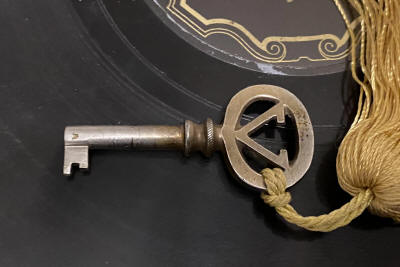 Standard
Victrola keys were included with most of the floor-model machines, with
plating to match the hardware. These were used to lock both the lid and the
record storage area. The classic "V" symbol dominated the design
Standard
Victrola keys were included with most of the floor-model machines, with
plating to match the hardware. These were used to lock both the lid and the
record storage area. The classic "V" symbol dominated the design
 The
"VV-330" model (and a few other high-end models) used a distinctive
key.
The
"VV-330" model (and a few other high-end models) used a distinctive
key. 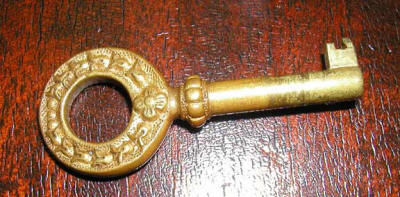 Some
of the Victrola "Period Models" also used a unique key design, such as this
one from an "Adam" model
Some
of the Victrola "Period Models" also used a unique key design, such as this
one from an "Adam" model
